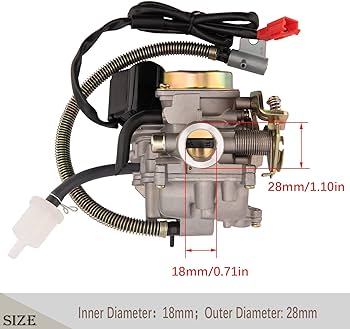A clogged exhaust in a 2-stroke engine can cause symptoms like loss of power and running rough. The exhaust may also emit excessive smoke and have a sour smell.
A 2-stroke engine’s exhaust system can easily get clogged due to carbon buildup, oil residue, and debris. This blockage restricts the flow of exhaust gases, leading to poor performance and increased emissions. Common symptoms of a clogged exhaust include reduced power output, rough idling, and excessive smoke from the exhaust pipe.
Addressing a clogged exhaust is crucial to ensure optimal engine performance and minimize environmental impact. We will explore the signs and effects of a clogged exhaust in a 2-stroke engine, as well as the steps to diagnose and remedy this issue.

Contents
Identifying 2 Stroke Clogged Exhaust Symptoms
When maintaining a 2-stroke engine, it’s crucial to recognize the symptoms of a clogged exhaust. Identifying these symptoms early can prevent engine damage and maintenance costs. Here are several key signs that indicate a potential clogged exhaust in a 2-stroke engine:
Decreased Engine Performance And Acceleration
A possible clogged exhaust can lead to decreased engine performance and sluggish acceleration. This can manifest as compromised power delivery and a noticeable drop in overall speed. Additionally, the engine may struggle to reach higher RPMs, indicating an obstruction in the exhaust system.
Unusual Engine Sounds And Excessive Noise
An obstructed exhaust can result in unusual engine sounds and an increase in excessive noise. The engine may produce an irregular and harsh exhaust note, suggesting restricted airflow due to a clog. This symptom may be accompanied by a rattling or vibrating noise from the exhaust system, indicating an issue that requires immediate attention.
Excessive Smoke And Foul Exhaust Odor
One of the clear indicators of a clogged exhaust in a 2-stroke engine is the presence of excessive smoke and a foul exhaust odor. The engine may emit thick, dark smoke, and an unpleasant smell due to incomplete combustion caused by restricted exhaust flow. This can also lead to environmental concerns and may indicate the need for exhaust system maintenance.
Difficulty Starting The Engine Or Erratic Idling
A clogged exhaust can cause the engine to experience difficulty starting or exhibit erratic idling. The engine may struggle to start or require multiple attempts, indicating reduced airflow. Additionally, when idling, the engine may run unevenly, causing fluctuations in RPMs and an unstable operation, highlighting potential exhaust blockages.
Increased Fuel Consumption
An underlying clogged exhaust can lead to increased fuel consumption as the engine struggles to efficiently expel exhaust gases. This symptom can manifest as a decrease in fuel efficiency, requiring regular and excessive refueling. Monitoring fuel usage can help identify potential exhaust issues and the need for further inspection and maintenance.
Common Causes Behind Exhaust Blockages
When it comes to maintaining a well-functioning 2-stroke engine, understanding the common causes behind exhaust blockages is essential. Here, we’ll delve into the key factors that lead to clogged exhausts, causing detrimental effects on engine performance. By identifying these issues early on, you can take proactive measures to prevent or resolve them.
Carbon Build-up From Oil And Fuel Mixture
One of the primary causes of exhaust blockages in 2-stroke engines is the accumulation of carbon build-up from the oil and fuel mixture. Over time, incomplete combustion can lead to the formation of carbon deposits in the exhaust system, obstructing the flow of gases. This not only hampers engine performance but also poses a risk of overheating.
Dirt, Debris, And Foreign Objects
Aside from carbon build-up, dirt, debris, and foreign objects can also impede the exhaust flow in 2-stroke engines. These unwanted materials can enter the exhaust system through various means, such as air intake or through the engine’s operation. As a result, they can obstruct the exhaust passage, causing back pressure and negatively impacting engine operation.
Corrosion Due To Moisture And Environmental Factors
Another significant factor contributing to exhaust blockages is corrosion caused by moisture and environmental factors. In 2-stroke engines, the exhaust system is susceptible to rust and deterioration due to exposure to moisture and harsh conditions. This can lead to the formation of blockages, hindering the efficient expulsion of exhaust gases.
Engine Modifications Impacting Exhaust Flow
Additionally, engine modifications can impact exhaust flow, potentially leading to blockages. Alterations to the exhaust system, such as the addition of aftermarket components or adjustments to the fuel-air mixture, can disrupt the balance of gas flow. This disruption can cause blockages and hinder the engine’s overall performance.
Effects Of A Blocked Exhaust On 2 Stroke Engines
When a 2-stroke engine’s exhaust becomes clogged, it can lead to a variety of detrimental effects on the engine’s performance and longevity. Understanding the potential consequences of a blocked exhaust is crucial for maintaining the health and efficiency of 2-stroke engines.
Impaired Exhaust Scavenging And Reduced Power
A clogged exhaust in a 2-stroke engine can hinder the process of exhaust scavenging, where the outgoing exhaust gases help draw in the fresh air-fuel mixture. This obstruction leads to poor scavenging efficiency, resulting in reduced power output. The exhaust gases are unable to escape efficiently, leading to an incomplete combustion process and ultimately robbing the engine of power.
Potential Engine Overheating
With a blocked exhaust, the exhaust gases cannot exit the engine as intended. This restriction can cause an increase in backpressure, leading to a rise in engine temperature. Overheating puts a strain on the engine’s components and can result in severe damage if not addressed promptly.
Increased Risk Of Engine Damage And Wear
When the exhaust system is clogged, the engine is forced to work harder to expel the exhaust gases. This added strain can lead to increased wear on internal components, such as the piston, rings, and bearings. Additionally, the heightened heat levels can contribute to accelerated degradation of engine parts, jeopardizing the overall longevity of the engine.
Deterioration In Fuel Efficiency And Lubrication
A blocked exhaust can have a negative impact on the engine’s fuel efficiency, as the hindered scavenging efficiency results in a less effective combustion process. Furthermore, improper scavenging can lead to inadequate lubrication of internal engine parts, potentially causing premature wear and reducing the engine’s overall performance.
Maintenance Tips For Optimal Exhaust Flow
Proper maintenance of the exhaust system is crucial for ensuring the optimal performance of your 2-stroke engine. By implementing the following maintenance tips, you can effectively prevent and address clogged exhaust symptoms, thus promoting a smoother running engine and extended lifespan.
Regular Exhaust System Inspections
Regularly inspecting the exhaust system for any signs of buildup and blockages is essential for maintaining optimal exhaust flow. When conducting inspections, pay attention to the exhaust pipe, muffler, and exhaust port for any noticeable obstructions such as carbon deposits or debris.
Proper Fuel And Oil Mixtures For 2-stroke Engines
The correct fuel and oil mixture play a significant role in preventing carbon buildup in the exhaust system. Ensure that you adhere to the manufacturer’s recommended fuel-to-oil ratio, as an improper mixture can lead to excessive carbon deposits within the exhaust components.
Cleaning And Decarbonizing Exhaust Components
Regularly cleaning and decarbonizing the exhaust components is crucial for maintaining optimal exhaust flow. Use a suitable solvent or cleaner to remove carbon deposits from the exhaust pipe, muffler, and exhaust port. Also, consider utilizing specialized tools to effectively remove stubborn carbon buildup.
When To Seek Professional Mechanic Assistance
If you encounter persistent clogged exhaust symptoms despite performing routine maintenance, it may be necessary to seek professional mechanic assistance. An experienced mechanic can conduct a comprehensive inspection and address any underlying issues contributing to the restricted exhaust flow.
Preventing Future Clogged Exhaust Complications
Clogged exhaust can lead to significant performance issues in 2-stroke engines, causing reduced power, increased fuel consumption, and potential damage to vital engine components. To avoid these inconveniences and costly repairs, it’s crucial to implement proactive measures to prevent future clogged exhaust complications. By establishing an ideal maintenance schedule, using recommended fuel additives and engine oils, and incorporating high-quality replacement parts, you can significantly reduce the risk of clogged exhaust in your 2-stroke engine.
Establishing An Ideal Maintenance Schedule
Regular maintenance is essential to keep your 2-stroke engine running smoothly and to prevent potential clogs in the exhaust system. Create a comprehensive maintenance schedule that includes routine inspections, spark plug checks, and exhaust system evaluations. By adhering to a consistent maintenance routine, you can identify and address any issues before they escalate into more significant problems, ensuring optimal engine performance and longevity.
Using Recommended Fuel Additives And Engine Oils
Utilizing high-quality fuel additives and engine oils specifically designed for 2-stroke engines can play a crucial role in preventing clogged exhaust. These additives and oils help keep the engine components clean and free from deposits that can contribute to exhaust obstructions. Follow the manufacturer’s recommendations when selecting fuel additives and engine oils, and make sure to use products that are formulated to minimize carbon buildup and maintain overall engine cleanliness.
The Role Of High-quality Replacement Parts
When replacing components in your 2-stroke engine, opt for high-quality replacement parts that are designed to meet or exceed OEM specifications. Inferior or substandard parts can contribute to clogs in the exhaust system, leading to decreased performance and potential damage. Choosing high-quality replacement parts ensures proper fit, function, and longevity, reducing the risk of future exhaust complications and maintaining optimal engine efficiency.
Monitoring Performance For Early Detection Of Symptoms
Regularly monitor your engine’s performance to identify any early symptoms of potential clogged exhaust, such as decreased power, increased exhaust smoke, or unusual engine sounds. Vigilant observation and timely action can help address issues before they escalate, preventing extensive exhaust blockages and minimizing the risk of damage to the engine components.
Frequently Asked Questions
What Are The Common Symptoms Of A Clogged 2-stroke Exhaust?
When a 2-stroke exhaust is clogged, you may notice a decrease in engine performance, increased exhaust smoke, and a sputtering or stalling engine. A clogged exhaust can also lead to higher engine temperatures and a distinct rattling noise.
How Can A Clogged Exhaust Impact Engine Performance?
A clogged 2-stroke exhaust can restrict airflow, leading to reduced engine power and efficiency. This can result in decreased acceleration, sluggish performance, and increased fuel consumption. Over time, a clogged exhaust can cause engine damage and reduce the overall lifespan of the motor.
What Are The Potential Causes Of A Clogged 2-stroke Exhaust?
A clogged exhaust in a 2-stroke engine can be caused by a buildup of carbon deposits, unburned oil and fuel residues, or a damaged or collapsed muffler. Sustained use at low speeds or improper fuel/oil mixtures can also contribute to exhaust blockages.
How Can I Prevent A Clogged 2-stroke Exhaust?
Regular maintenance, including cleaning and inspecting the exhaust system, using high-quality fuel and oil mixtures, and avoiding prolonged periods of low-speed operation, can help prevent clogs. Additionally, ensuring proper air/fuel ratios and regular tune-ups can minimize the risk of exhaust blockages.
Final Thoughts
A clogged exhaust in a 2-stroke engine can lead to serious performance issues. Ignoring the symptoms can lead to costly repairs. Understanding and addressing these signs early can greatly extend the life of your engine, ensuring smooth and efficient operation.
Don’t overlook these symptoms, as they can be indicative of more serious issues. Keep an eye on the signs and act promptly to avoid any further damage.


